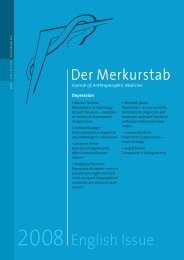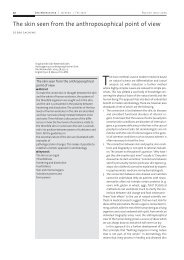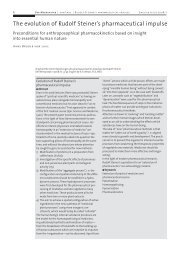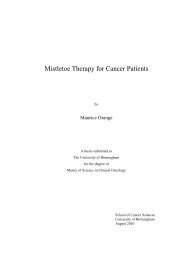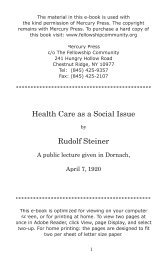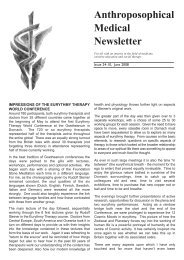Kienle Breast Cancer.pdf - AnthroMed Library
Kienle Breast Cancer.pdf - AnthroMed Library
Kienle Breast Cancer.pdf - AnthroMed Library
You also want an ePaper? Increase the reach of your titles
YUMPU automatically turns print PDFs into web optimized ePapers that Google loves.
Table 9: Animal Studies of VAE Compounds in <strong>Breast</strong> or Gynaecological <strong>Cancer</strong> (transplanted human or murine tumours) (Continued)<br />
Other gynaecological tumour<br />
Ovary, SoTü 3, ip Mice (SCID) rML 30 ng/kg, ip, qd *<br />
5 * 12<br />
35% mice alive at<br />
day 84<br />
40% tumour-free mice<br />
at day 84<br />
[134]<br />
rML 150 ng/kg, ip, qd<br />
* 5 * 12<br />
10% mice alive at<br />
day 84<br />
10% tumour-free mice<br />
at day 84<br />
rML 500 ng/kg, ip, qd<br />
* 5 * 12<br />
75% mice alive at<br />
day 84<br />
65% tumour-free mice<br />
at day 84<br />
Control<br />
15 mice alive at day<br />
84<br />
10% tumour-free mice<br />
at day 84<br />
Uterusepithelioma<br />
T-8 Guérin<br />
Rats<br />
Polysaccharide<br />
("Viscumsäure"), ip,<br />
qd * 6<br />
Moderate effect [133]<br />
All experiments did have control groups, but these were only mentioned if necessary for results.<br />
sc: subcutaneous; it: intratumoural; ip: intraperitoneal; iv: intravenous; w: week;<br />
qod: every other day; qd: every day; T/C: treated tumour/control tumour; ILS: increase in life span.<br />
I Application of 10 g/kg of proteins had toxic effects<br />
local recurrences were reduced after application of VAE or<br />
of VAE-activated macrophages; one study found no benefit.<br />
All experiments using local VAE application found a<br />
benefit in relation to survival and tumour-growth inhibition.<br />
In rats, no clear benefit of VAE could be seen. Results<br />
from applying isolated or recombinant VAE compounds<br />
were inconsistent: some moderate effects of proteins (e.g.<br />
lectins) or polysaccharides were observed in relation to<br />
survival and tumour growth, while others observed none<br />
or possibly also adverse outcomes.<br />
Cervical cancer<br />
Clinical studies: Survival (Table 3) was investigated by one<br />
RCT and three non-RCTs: all four reported a beneficial<br />
outcome which, however, was statistically significant only<br />
in the non-RCTs. Tumour behaviour (Table 4) was investigated<br />
by one non-RCT, which could not find an effect on<br />
disease recurrence or metastases mainly because these<br />
events scarcely occurred. One single-arm study reported<br />
41% complete and 27% partial remissions in CIN after<br />
VAE application. QoL (Table 5) was assessed in one RCT<br />
and one non-RCT; both reported a statistically significant<br />
benefit.<br />
Regarding preclinical studies (Table 7), only HeLa cells were<br />
investigated; here VAE and protein fractions showed cytotoxic<br />
effects.<br />
Uterus cancer<br />
Clinical studies: Survival (Table 3) was investigated by two<br />
RCTs and two non-RCTs; three reported a statistically significant<br />
benefit while one found no difference. QoL (Table<br />
5) was assessed by one RCT and one non-RCT; both found<br />
a statistically highly significant benefit.<br />
Regarding preclinical studies (Tables 7 and 9), VAE and isolated<br />
ML I showed cytotoxic effects in different human<br />
uterus cancer cells. Concerning animal experiments, a patent<br />
specification mentions "moderate" effects of mistletoe<br />
polysaccharides on tumour growth in uterusepithelioma.<br />
Ovarian cancer<br />
Clinical studies: Two RCTs and two non-RCTs investigated<br />
the influence of VAE on survival (Table 3) and reported a<br />
benefit, one of each with statistical significance. Tumour<br />
behaviour (Table 4) was investigated by two RCTs, each<br />
combining VAE and chemotherapy (plus radiotherapy in<br />
one study): these reported comparable outcomes. The<br />
influence of VAE on QoL and tolerability of chemotherapy<br />
and radiation (Table 5) was investigated by three RCTs and<br />
one non-RCT; all of them reported a statistically significant<br />
positive effect. In one trial using an aggressive chemotherapy<br />
protocol, higher dosages of Cisplatin and<br />
Holoxan could be given in the VAE group as the side<br />
effects were less intense [63]. One single-arm study<br />
applied recombinant lectins in ovarian cancer but found<br />
no remission.<br />
Regarding preclinical studies (Tables 7 and 9), VAE showed<br />
cytotoxic effects in various ovarian cancer cells. In SCID<br />
mice, rMLs led to increased survival and to more tumourfree<br />
animals at the highest and lowest dosage, while no<br />
effect was observed at the medium dosage.<br />
Genital cancer<br />
Clinical studies: One non-RCT (published in 1963)<br />
reported partly improved disease-specific survival (Table<br />
3). Regarding preclinical studies (Table 7), VAE showed<br />
cytotoxic effects in vulvar cancer cells.




